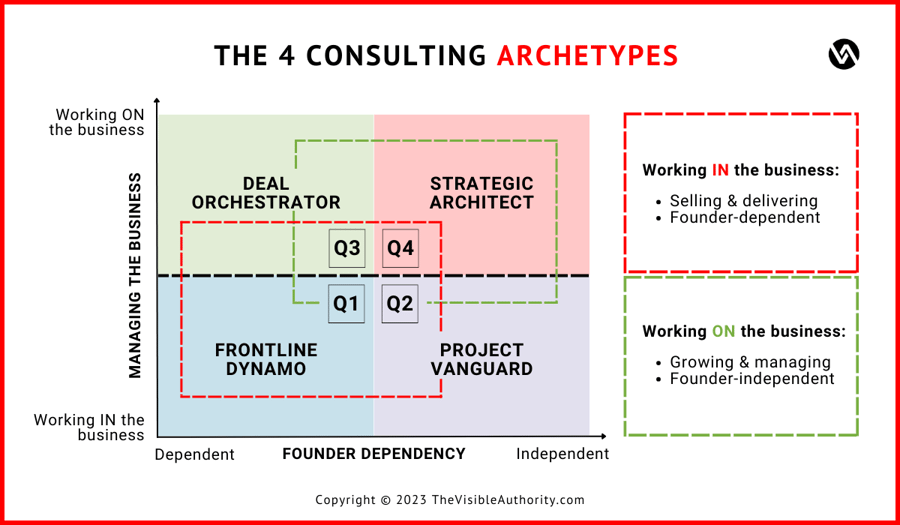
Moving Away From Early-Stage Characteristics as a Boutique Consultancy

In my work with consultancies, one of the advantages I have is being an outsider. Often, boutique consultancy owners and consulting leaders are so entrenched in the hustle of daily operations that taking a step back to impartially review their business becomes a real challenge.
Having reviewed the performance of dozens of consultancies in the last few years and having advised investors/buyers in their vetting of boutique consultancies for potential acquisitions, I've noticed a critical trend.
One key realization is that many boutique consultancies, even those over 5-6 years old, often remain stuck in early-stage characteristics. This stagnation seriously hinders their evolution towards the maturity needed for sustained growth and profitability.
In this article, I will explain why stepping away from early-stage characteristics is vital for transitioning into a mature consulting business.
The journey from early-stage to mature consultancy
Here is a typical story of how consultancies get started.
A handful of talented partners come together. They usually have strong domain expertise. They come either from larger consulting firms or were previously corporate executives. They have a very strong sales drive and service-delivery mindset.
Here is where often problems begin. After 2-3 early-stage years, these founders should be, in theory, starting to relinquish control over day-to-day operations. The consultancy should be at a point where its top leaders can gradually move toward more strategic tasks of running a business instead of managing the daily grind.
Unfortunately, there are many consultancy owners that, even 5-6 years later, still find themselves overburdened with hundreds of operational tasks, which often leads to getting stuck in several ‘hard-to-get-rid-of’ early-stage characteristics.
Recommended reading: How Boutique Consultancy Owners Can Reclaim Their Quality of Life
Early-stage consultancies share a mix of the following characteristics
- Positioning clarity and service validation challenges (service-market fit)
- Revenue and profit unreliability, with many ups and downs, causing instability in the consultancy and a tendency to accept non-fit clients or projects (to protect revenue - a vicious loop)
- No trust-building at scale – no case studies, client testimonials, social proof, or impactful reputational footprint
- A top-heavy structure (making the costs also top-heavy) – the first few hires tend to be senior-level consultants with strong backgrounds and expertise (an absolutely normal approach)
- Low-level infrastructure investments – CRM, project automation (PSA), financial reporting, etc. A lot of the work is ad hoc, going with the flow (supported by the Excel sheet)
- Lack of standardization of processes (efficiency) and productization of services (marketing), which doesn’t help the pitch narrative either (the narrative gets adjusted to the client or proposal)
- Due to the lack of standardized methodologies, there is also very little structured data gathering to study (and reduce) the variability and predictability of future project outcomes
- The quality of life of the founders/owners/leaders is challenging – they are overwhelmed with too many tasks
It is normal for these characteristics to be present in the first couple of years. However, if they remain beyond the early-stage years - 5-6 years into the journey – it most likely becomes a road to trouble.
Recommended reading: Why Repetition Is the Path to Becoming a High-Performance Consultancy
A helpful framework: the four consulting archetypes
In a recent article for PSA software vendor Deltek, I developed a consulting archetype visual representation to help consultancy owners identify where they are in their maturity journey.
This is not a scientific study but my 'Experience Quadrant' – an attempt to create a thoughtfully constructed framework distilling years of my professional interactions and learnings into an accessible reference tool.
The archetypes can help consultancy owners or leaders understand how to design their roles and responsibilities for future success.
The core message in this ‘Experience Quadrant’ is the visual representation of moving away from early-stage characteristics toward a more mature business strategy.
The move from ‘below the line’ (working IN the business) to ‘above the line’ (working ON the business).
(‘the line’ is the dotted horizontal line, the split between Q1/Q2 and Q3/Q4)

Overview of the quadrants
- Q1: Frontline dynamo – this person can be found deep in the project trenches, is very hands-on, operationally focused, and typically has very strong technical skills.
- Q2: Project vanguard – this is typically someone who strives for operational excellence, has limited involvement in sales, and is heavily involved in managing and leading projects. This archetype has an interest in project financials but lacks interest in the consolidated financials of the consultancy.
- Q3: Deal orchestrator – this is the rainmaker of the consultancy, a key accounts leader. These leaders are very intuitive about spotting opportunities. Typically, these are the ones who present at conferences, take client meetings, and connect with people. However, their financial monitoring is rather selective (sales only).
- Q4: Strategic architect – this is the strategic visionary type who delegates sales and operations. Those who fall in this archetype are business development-focused, are on top of the consolidated financials of the business, work on service offering design, and, of course, actively participate in team development and mentorship.
Nobody falls into a single quadrant
It’s important to note that barely anyone falls precisely into a single quadrant. Almost every consulting leader and consultancy owner I mapped onto the quadrant has been a blend of two or more archetypes.
However, there appears to be a rather prominent split between:
- those who work in the business (the lower two quadrants below the dotted line), and
- those who work on the business (the upper two quadrants above the dotted line).
That means most leaders either showcase a stronger Q3/Q4 ‘managerial blend’ or a stronger Q1/Q2 ‘operational blend’.
Working IN the business and leaning more toward Q1 and Q2 is pretty natural in the early stages. The focus is on selling and delivering.
However, over time, consultancy owners must make plans to turn their businesses into founder-independent consultancies and strive to switch to working mainly ON the business: managing and growing.
Founder-independency is one of the signs of a mature business.
Unfortunately, this deliberate and well-organized upward move does not always happen in consultancy firms. And it should.
A few interesting statistics
Earlier this year, I mapped 162 of my consultancy owner clients and connections onto the quadrant.
Once again, almost all showcased more than one tendency, so the numbers below represent which quadrant they have the strongest tendency toward:
- Q1, Frontline Dynamo: 26%
- Q2, Project Vanguard: 12%
- Q3, Deal Orchestrator: 44%
- Q4, Strategic Architect: 18%
Looking at it from a below/above-the-line perspective:
- Below the line (working more IN the business): 38%
- Above the line (working more ON the business): 62%
These people were all owners, founders, or partners in boutique consultancies:
- existing > 5 years
- with > 2M revenue (euro)
- and > 20 consultants
In my opinion - more than 5 years after the start - almost 40% of the owners/founders aren’t sufficiently working ON the business and are instead working too much IN the business.
This approx. 40% of ‘below-the-line leadership’ will likely struggle to reach the level of above-the-line maturity they need to manage and grow the consultancy. They risk getting stuck in a vicious loop of early-stage characteristics and unstable circumstances.
Overall, I consider the leadership in these consultancies:
- Working too much IN the business
- Focusing too much on selling and delivering, not enough on managing and growing (working ON the business)
- Too much maintaining a founder-dependent environment
- Not having built enough foundations for further growth
In conclusion
The journey of boutique and mid-sized consultancies is dynamic and marked by distinct stages and challenges.
I've observed the common pitfalls that hinder their growth and maturity. My archetype ‘Experience Quadrant’, detailing the four consulting archetypes and the below/above-the-line split, can be a valuable methodology for boutique consultancy owners to identify where they currently stand in their leadership journey and where they need to steer their business for long-term success.
It’s about understanding the strong connection between leaving behind early-stage characteristics and the need for consultancy leaders and owners to start spending more time working on the business instead of in the business.
I encourage boutique consultancy owners to move ‘above the line’, working more ON the business and leaving the early-stage characteristics behind in a conscious and deliberate consultancy firm design.
Interested in receiving all my learnings to build a better consultancy? Subscribe to my bi-weekly newsletter.

Luk’s extensive career in the consulting business, which spans more than 20 years, has seen him undertake a variety of influential positions. He served as the European CHRO for Nielsen Consulting (5,000 consultants in the EU), founded iNostix in 2008—a mid-sized analytics consultancy—and led the charge in tripling revenue post-acquisition of iNostix by Deloitte (in 2016) as a leader within the Deloitte analytics practice. His expertise in consultancy performance improvement is underlined by his former role on Nielsen's acquisition evaluation committee. After fulfilling a three-year earn-out period at Deloitte, Luk harnessed his vast experience in consultancy performance improvement and founded TVA in 2019. His advisory firm is dedicated to guiding consulting firms on their path to becoming high-performing firms, drawing from his deep well of consulting industry expertise and financial acumen.

